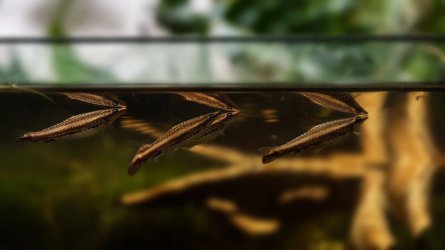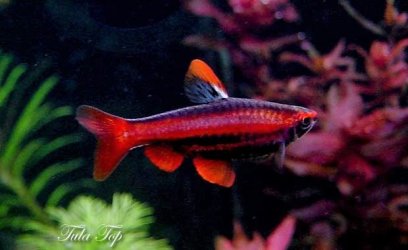I do like the pencil fish and the rasboras. Hatchets are cool,I just don't want to change my filter set up or cover up the holea they could jump through. I'd like to keep them someday though. I love the red in some of the pencil fish. The Rasboras are really pretty too.
For surface fish, the rocket pencilfish as it seems to be commonly called,
Nannostomus eques, is ideal. I have had a group of a dozen or so for many years (so long I have replaced the originals that died of old age with younger fish to maintain the group), and they remain together almost continually, close to the surface, among floating plants. This is not a brightly coloured species, but it is one of the more peaceful (male squabbles are interesting and in my experience never lead to anything serious) of the pencils, swims at an oblique angle, and as I say at or very close to the surface. Mine spawn regularly, though the tiny eggs deposited on the undersides of leaves get eaten before they hatch, except once or twice. Photo below (not my fish, just a good photo of the species). A group of 10-12 would be fine in a 20g with floating plants.
Among the red-hued pencils, none is more beautiful than the coral red,
Nannostomus mortenthaleri (photo below). This species is another very peaceful one, and when I had them (they are very rare here, only saw them once many years ago now) they separated out (unlike the above) and seems to swim just about everywhere in the middle 2/3 of the tank. They need lots of plants or branches in the mid-tank region. A group of at least six, up to maybe eight. Another red newer discovery is
N. rubrocaudatus, but the red is not quite as extensive as on
N. mortenthaleri. Rarely seen, I had a group about nine years ago but have not seen them since locally. These fish are obviously all wild caught, and expensive for import, so there is not as wide a market for them.
The dwarf pencilfish,
Nannostomus marginatus, is another peaceful shoaling pencil. This species has quite a large range over parts of the Peruvian, Brazilian and Guyanan regions, and there are subtle differences in the geographically-isolated populations. This fish swims the same as the coral red, spread out and over the middle 2/3 region. A group of 8-9 minimum.
Considering the 20g tank, with the cories, you could have the group of N. eques and a group of one of the others.
Inj one of the photos there is a cardinal tetra in the background, and this is a species suited to the same environmental conditions. But given its size, the smaller false or green neon,
Paracheirodon simulans, in a group of 9-10 would be a nice addition with the two pencilfish groups and cories. This species tends to remain in the lower half. It is very closely related to the cardinal, differing in its DNA by only a few chromosomes.








